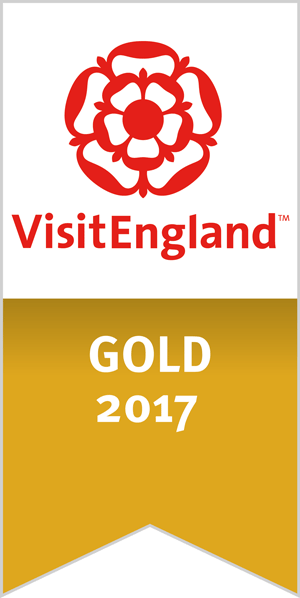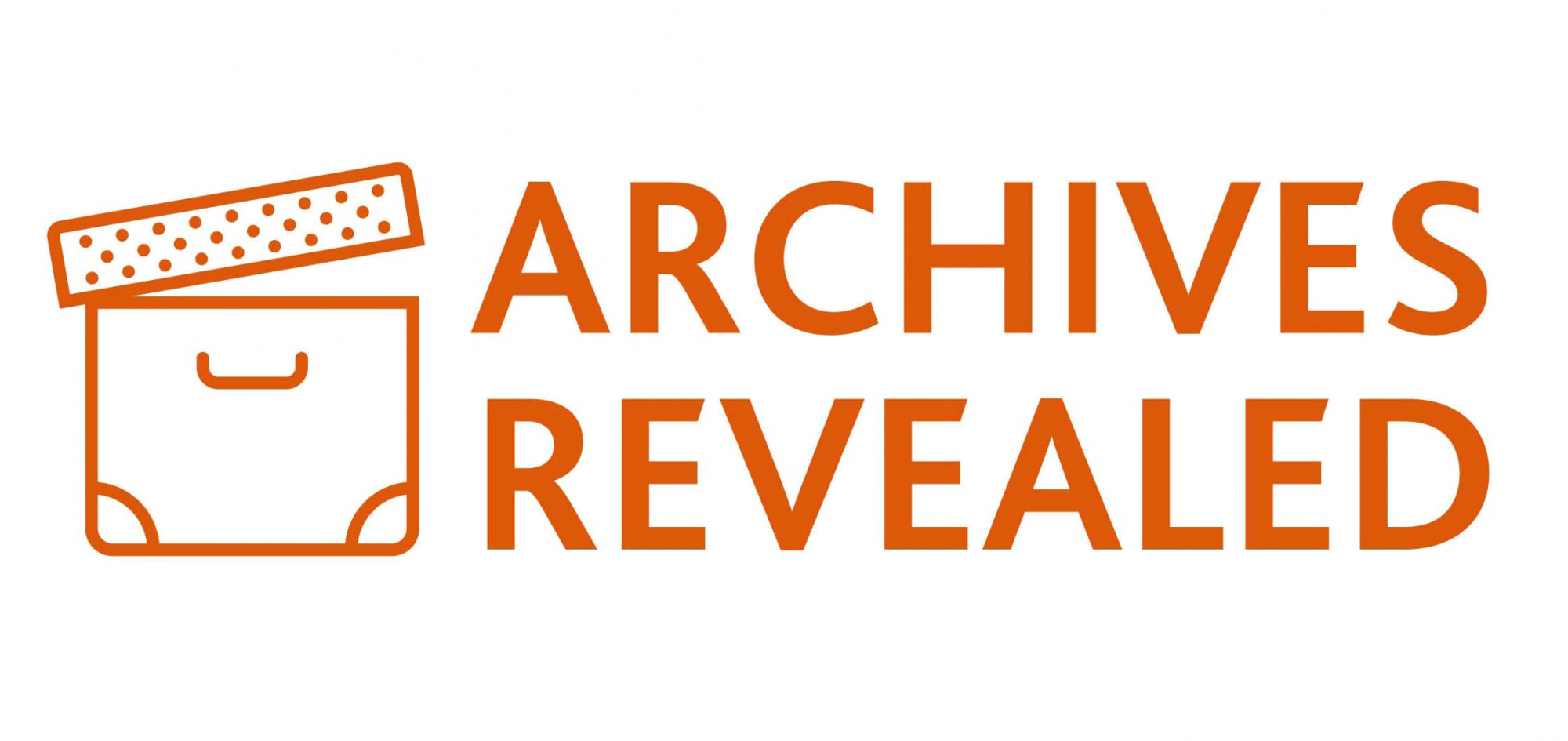Metro at Forty
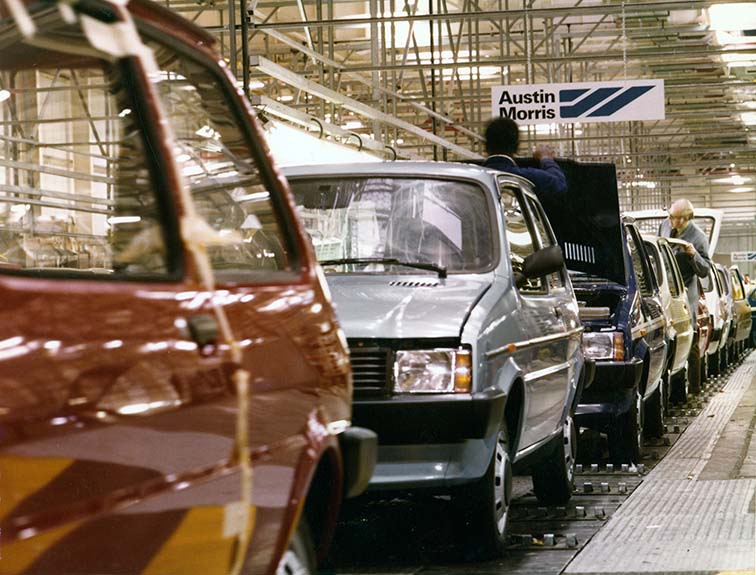
Introduction
After almost five years without announcing a brand new vehicle, the release of the Austin Metro was highly anticipated. Designed to be a replacement for the Mini, the Metro didn’t quite surpass its little brother during its run. Whilst many companies had already begun to investigate the super-mini market, British Leyland and the Metro entered late into the race. After a last minute redesign, the revised Metro made its grand entrance to the public in 1980.
Despite being the butt of many jokes over its lifetime, the ‘everyday’ looking Metro remains one of the top ten best selling cars in the UK. It remained popular with the British public throughout its production life, despite becoming a relatively old design by that time. Forty years on we now want to celebrate the little car that had such a big impact…
The Metro was born from a Mini replacement project known as ADO88.
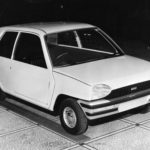
Before the Metro
In 1975 Sir Don Ryder complied a report as the head of the UK National Enterprise Board. “British Leyland: The Next Decade” listed his recommendations to secure the future of the company. This list included merging all the manufacturers, including those of commercial vehicles as well as cars, to limit the number of competing vehicles and factory locations. It highlighted significant overlap in vehicles ranges and suggested limits to the number of vehicles produced as well as development for efficient future vehicles.
Organisational restructures as laid out by the report meant that the company almost came under national control by the end of the 70s – with the government owning the majority of the shares. Whilst the company remained public, this Government support provided much needed financial help and prevented the company going into bankruptcy. Despite this, by the 1980’s, the newly named British Leyland Motor Corporation was once again struggling.
In a time that saw active Union action and workforce walkouts, coupled with a fuel crisis that was demanding more cost efficient cars, the company was in need of a fresh approach but had limited finances for development.
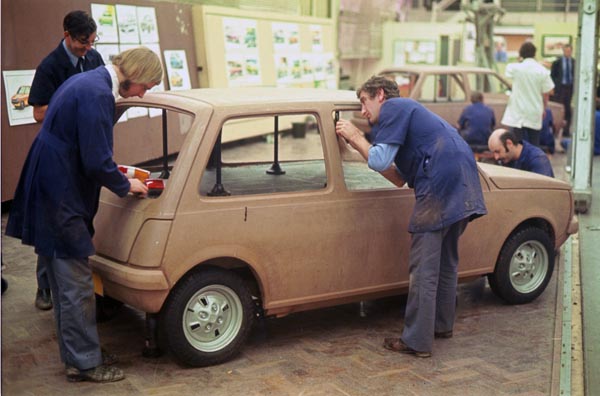
1975 ADO 88 full-size model in the Design Studio in the former Commercial Vehicle Showroom at Longbridge.
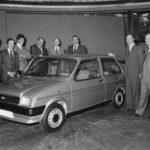
Launched as the Austin Mini Metro in 1980, the codename for the project was LC8 (Leyland Cars 8).
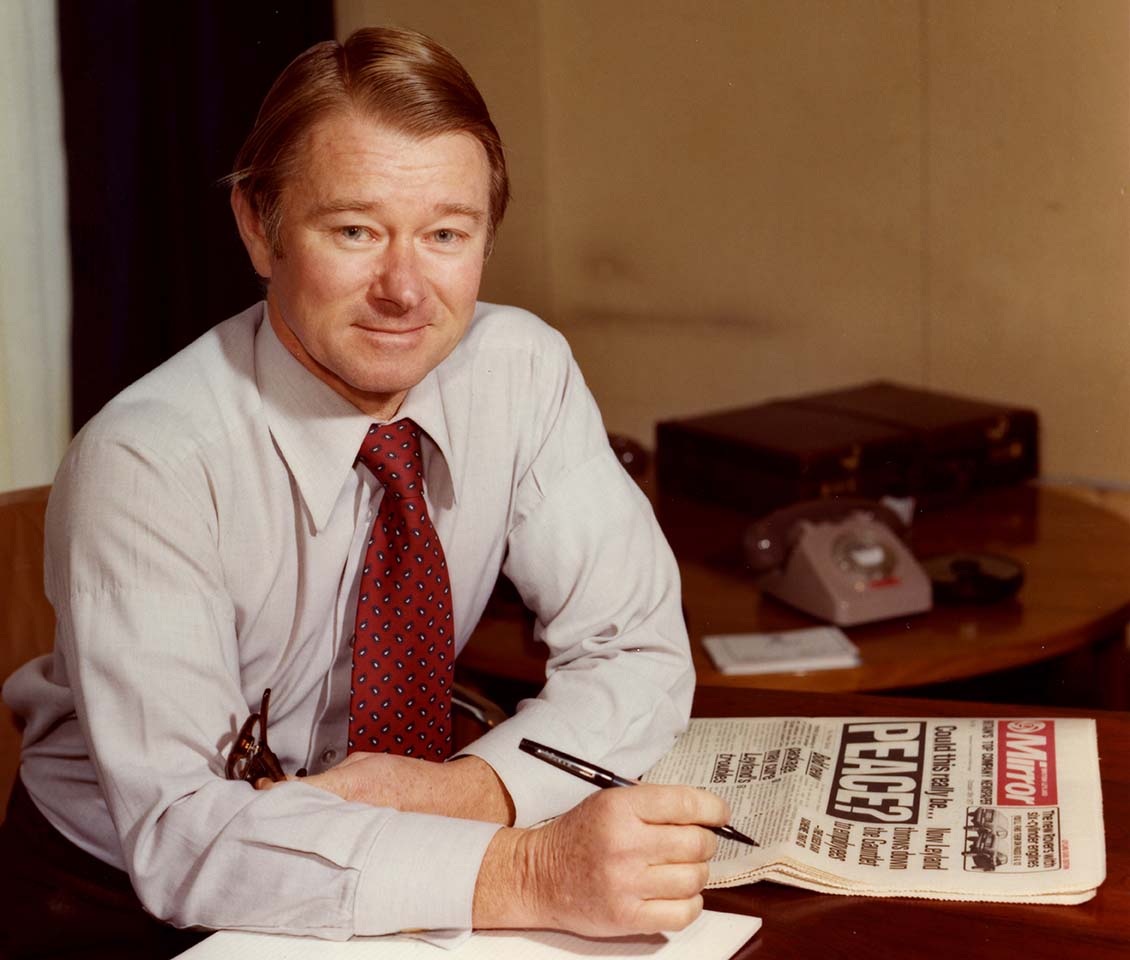
1977 Sir Michael Edwardes in his office at Longbridge with a copy of the Leyland Mirror
Before the Metro
In 1977 Michael Edwardes became Chairman of British Leyland, and was key to pushing through the Metro project. He pushed to upgrade the available technology and in turn improved productivity in the factories. His approaches to dealing with the Unions and workforce allowed the Metro to develop and provided a much needed turnaround for the company – at least for the time being.
As ADO88 was being prepared for production, poor feedback from focus groups Indicated that the car looked too ‘utilitarian’ and ‘van-like’. This brought David Bache into the picture. Previously one of Rover’s first car ‘stylists’ who was involved in the design of the Range Rover and the Rover SD1, Bache led a last minute overhaul of ADO88. This redesign ended up altering every exterior panel of what would then become the more appealing LC8 – the Metro.
During the redesign, every external panel was altered to become smoother and more aerodynamic.

Automated Assembly
As part of a large scale expansion of the British Leyland factory at Longbridge, planning for the new Metro line began in 1975. Time was short to get it ready in time for the Metro’s launch in October 1980.
New West Works was a first for British Leyland. £15.5 million was invested in the highly automated and advance production line, which used extensive robot input.
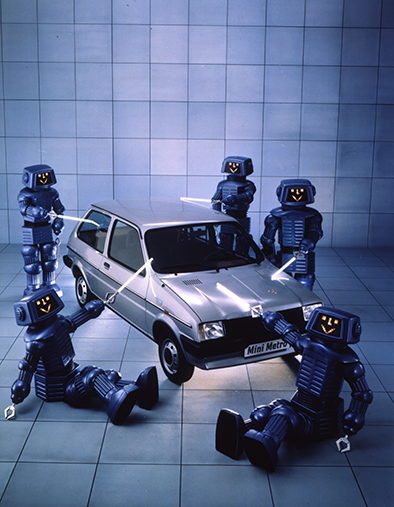
1981 advertisement for the European export market with a humorous take on the advanced robot technology used to build the car.
LC8 was different enough from ADO88 that all the vehicle testing had to be redone.
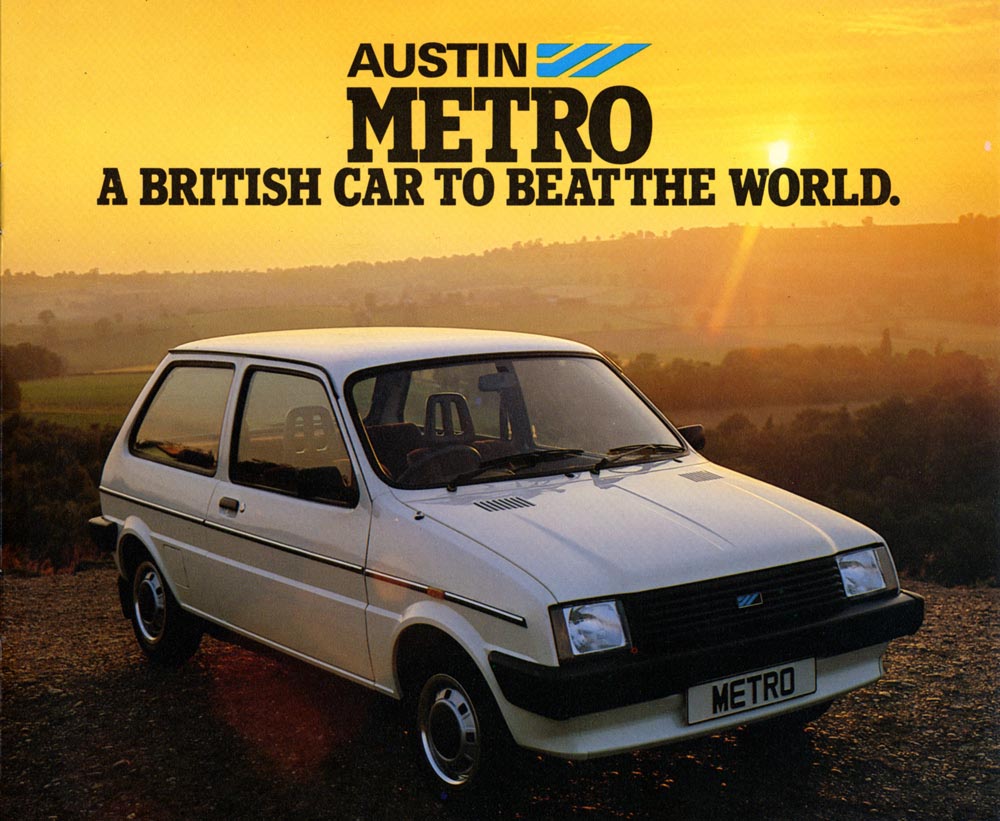
Marketing the Metro
Following Britain’s entrance into the common market, the Metro was designed to rival the Ford Fiesta, Renault 5, Fiat 127 and Volkswagen Polo. The hatchback’s newly designed body shell was the most spacious of all its competitors, with the addition of a split 60/40 rear seat; and was key to its overall success
With the commissioning of an advertising campaign led by The Leo Burnett advertising agency the strapline for Metro “A British car to beat the world” was presented. Much of the marketing revolved around patriotism and supporting the British brand over “foreign invaders”. This was an attempt to combat increasing bad press regarding job losses and factory closures. By 1981 Metro had become one of the bestselling mini cars in the UK. Its successful ad campaign complemented the nautical theme of the dealer and fleet launch on, held on cruise liner MS Vistafjord.

1980 Austin Metro colour and trim guide. Colours ranged from Applejack to Emberglow as well as metallic options such as Peridot and Silver Birch. The interior trim options included vinyl, marle fabric or even velour. These options were only available in certain colour combinations, helpfully explained by the chart on the back of the guide.
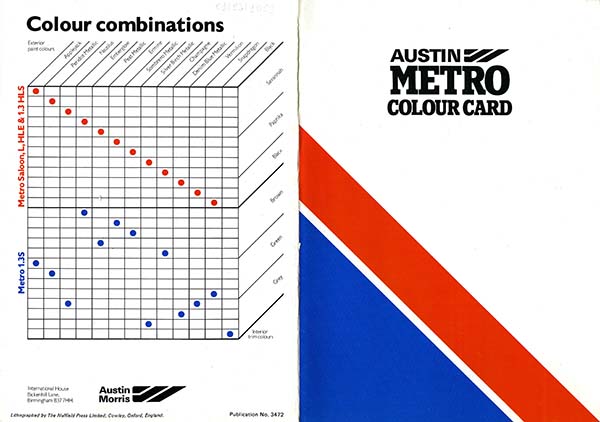
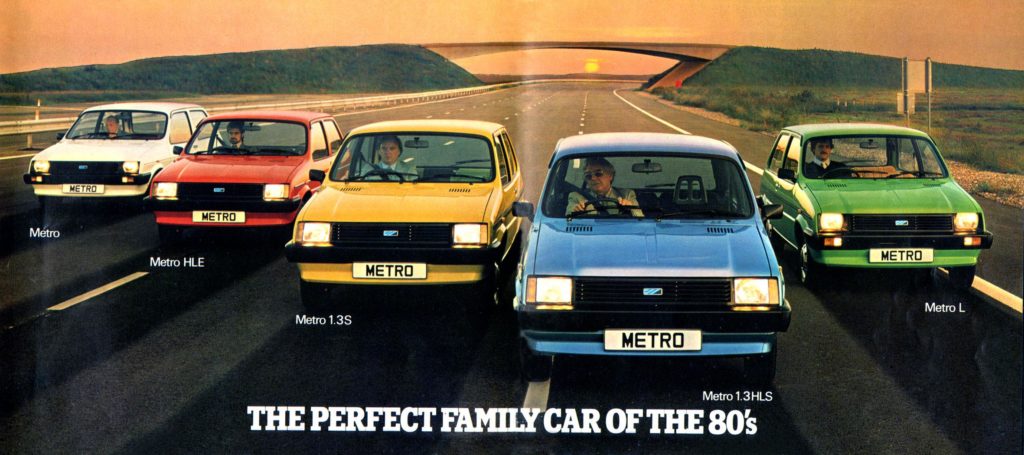
Quality Control
With changes to the A-Series engine, the Metro embodied good fuel economy and reduced service needs. More space, folding seats and quality interiors would allow people to downsize their vehicle whilst still having some benefits of larger cars. Prices ranged from £3,095 – £4,296 dependent on the model specifications.
From the outset, quality was central to the development of the Metro with engineers being involved right from the start. They were able to make changes to the design and manufacture throughout the process. This was true for each fault even when this meant substantial changes to the design.
The automated body lines in the factories meant that two body shells could be completed in only 45 seconds! Not only did British Leyland become leaders in the use of new technologies for production, but they had breakthroughs in quietness as well as fuel consumption. The testing programme lasted five years and covered two million miles.

Metro reliability poster. One of a series that shows how the Metro City is both reliable and economic.
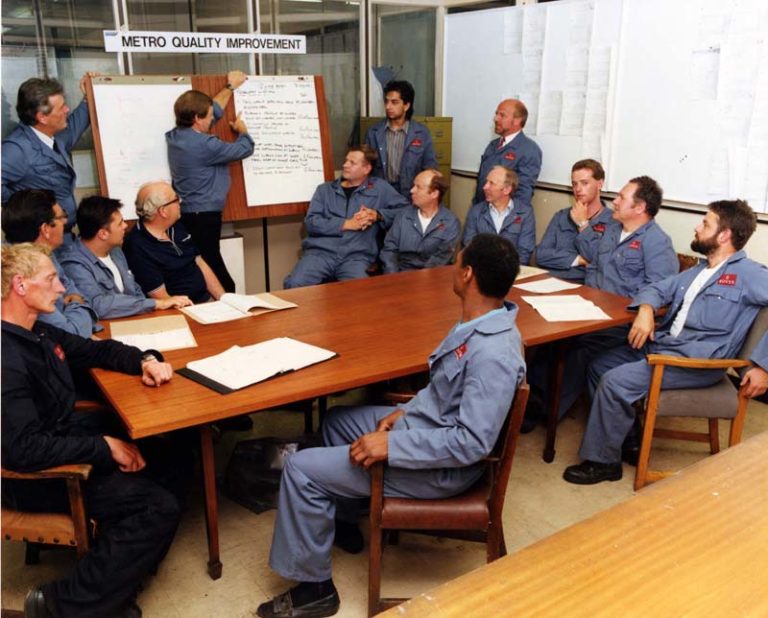
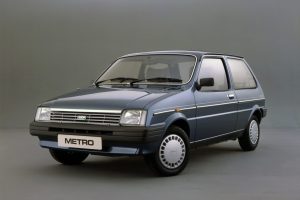
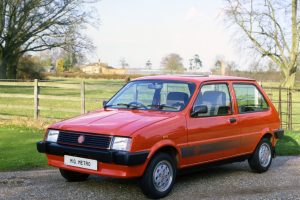
The Metro was badged as an Austin, MG and Rover Metro during its almost two decade long run. It became the Rover 100 Series in 1994.


More from the Archive
-
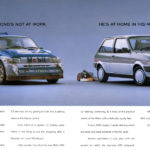
- One of a series of posters promoting the adaptability of the MG Metro 6R4 as both a family vehicle and a rally car. It was produced after Tony Pond’s 1985 season driving for Austin Rover where he finished third overall on the 6R4’s international debut at the Lombard RAC Rally.
-
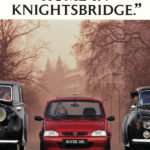
- In December 1994 the Metro name was finally replaced with the Rover 100, which had been the European name for the Metro from its launch. Despite the name change however the mechanics of the car were virtually the same, including the Hydragas suspension.
-
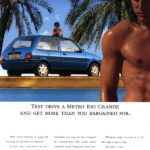
- The tag line for the Metro Rio was ‘Above all its a Rover’. This was released in 1994 along with the slightly voyeuristic television advert. To promote the car the song ‘Rio’ by Duran Duran was heavily used and even given away on CDs at dealerships.
-
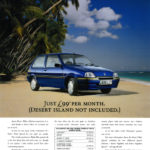
- This was another Metro special edition with pearlescent ‘Tahiti Blue’ paintwork and ‘Harlequin’ pattern seat covers. Released in 1993, the television advert for this depicted the Metro being paddled up river, arriving in the big city.
-

- The Joan Collins posters were created in 1993 coinciding with a series of sales brochures, press material and even a television advert with Joan driving a Metro 1.4 GTi.
-

- The Metro Mayfair was launched as a special edition Mayfair range alongside the Mini, Maestro and Montego. Although marketed as ‘an Aristocratic Austin’ Austin Rover were keen to promote the Metro Mayfair as spacious and the ideal car for the city.
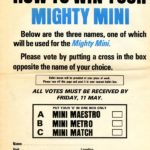
The name 'Metro' was chosen through a workforce ballot.
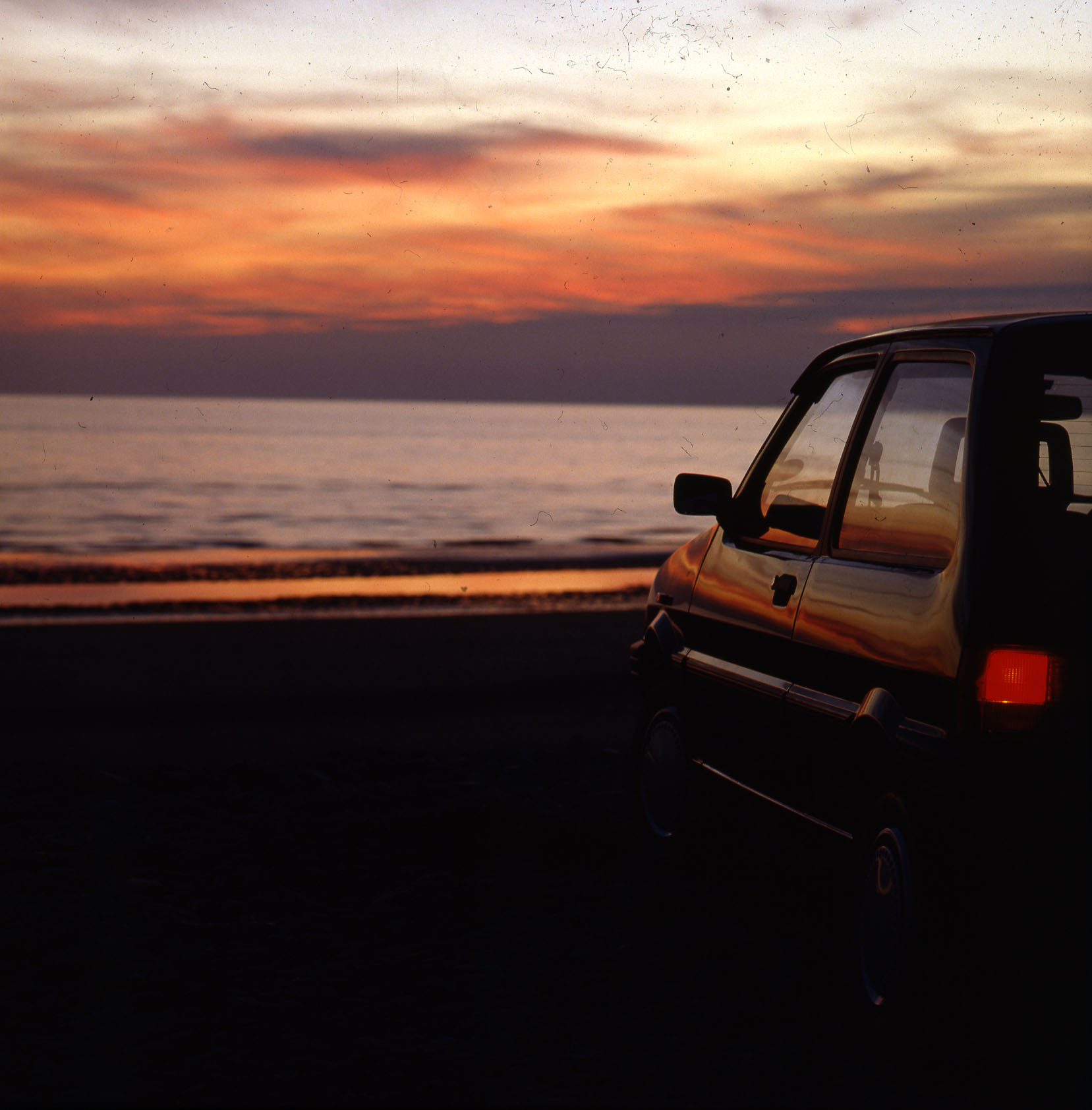
Smooth Sailing?
The Metro was considered to be such an important turning point for the company that well over £1 million was allocated to its dealer launch on a cruise liner. Planning for the Austin Metro press launch began in 1978, more than two years before the car was expected to make its public appearance.
With over 2000 sales outlets across the UK, any new model launch involved bringing the representatives to a central location. A large venue was clearly required.
The MS Vistafjord was chartered, making a total of eight trips to the Isle of Man from Liverpool in September 1980.
The theatrical reveal of the Metro on board the cruise liner overall hosted 3200 people, however, due to very heavy seas during one of the eight trips, some of the guests unfortunately succumbed to sea sickness during their short voyage. This combined with the weather meant they were unable to take part in a test drive whilst on the island!
Material donated by Ken Clayton
The Cruise liner MS Vistafjord, selected for the press launch of the Metro actually outlived the car in its service from 1973 to 2004.

Metro Mania
The car became an icon in its own right. Despite it initially being designed to be a replacement for the Mini, the Metro instead ended up fitting snugly between the small Mini and the larger Allegro. Although never really considered to be quite as fashionable as the Mini it was supposed to replace, the Metro temporarily saved British Leyland with over 130,000 selling in the UK alone during 1983.
The redesign and relaunch over its lifetime led to great success. In 1990 the Metro was voted Best Small Car in the World by Autocar and Motor, but in the end the Metro was unable to keep up with its competitors. By the late 1980s British Leyland were finding it increasingly difficult to compete within expanding foreign markets. Sales began to drop in favour of other vehicles such as the Ford Fiesta.
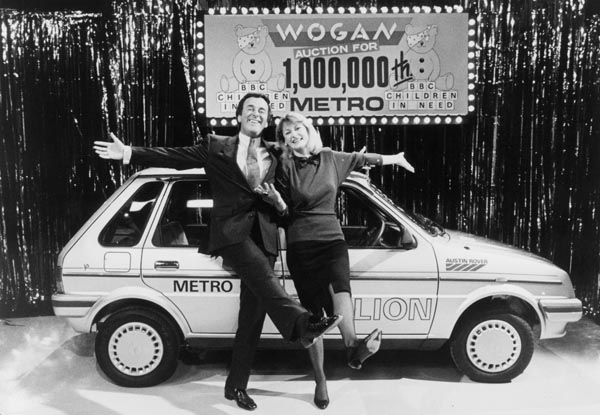
1985 BBC Children in Need. Terry Wogan and Sue Cook auctioning the one millionth Metro. This is a top range Vanden Plas five-door model.
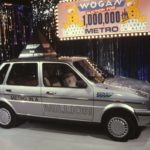
More than two million Metros were built over the 18 year production run.
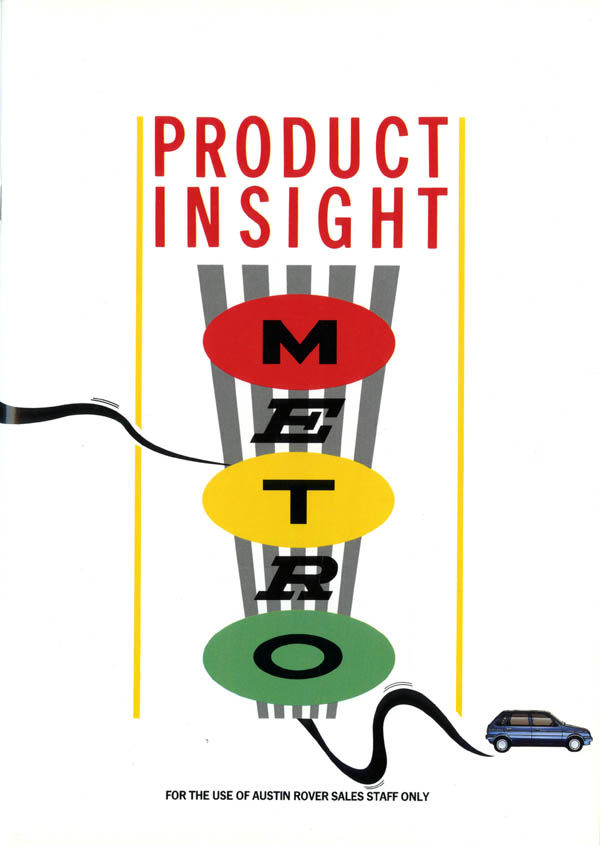
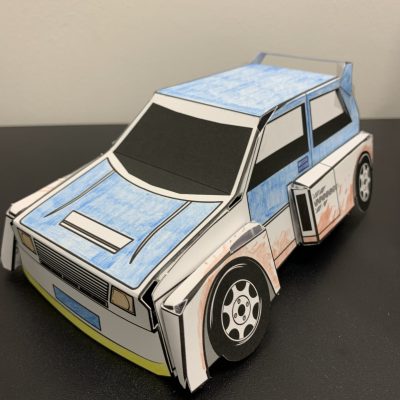
Fancy making your own Metro 6R4?
Activity available to purchase from the British Motor Museum gift shop.
Get Involved
Metro & Me
During its 18 years in production, the Metro went on to become an everyday classic, with a special place in the memories of many.
Did you drive or own a Metro? Maybe you learnt to drive in one? We would love to hear and share your stories and picture of you and your Metro in our ‘Me & my Metro’ section. Get involved by emailing us at: museum@britishmotormuseum.co.uk
-
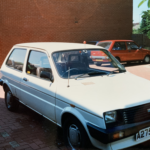
- Sara W: Kayleigh was my first car, bought from my sister in law. I hadn’t passed my test and she sat on my drive for a few months whilst I took 5 attempts to pass my test! She was a lovely car, very reliable and went to car heaven shortly before her 18th birthday. The mechanic rang me and said “We’re half way through the MOT and the repair bill is in four figures, shall we stop?” I sobbed. I still have her number plate and fond memories.
-
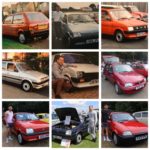
- Tom M: Metro have been a part of my life since 1995 when my brought a Rover Metro 1.1C which I learnt to drive it and then brought a Metro Knightsbridge as my first car and began goIng to car shows with it. I have looked after a number of Metros over the years and owned my current 1.3L Clubman Automatic for 11 years and my 1.3GS for 8 years. They are both my pride and joy and I have always had lots of affection for Metros – a British car to beat the world! They have both attended a countless number of events at Gaydon.
-

- Paul T: I passed my test in a mk2 metro with BSM in June 1987 aged 17 years and 3 months! I’ve barely been without one ever since, owning 10 in total. My latest one is an immaculate mk1 MG which has been fully restored partly by myself. It gets waves and thumbs up on every trip. Had it for year now It was featured in this month’s MGOC mag as a centerfold! I love them and they are sought after now as they are still way cheaper than a mini.
-
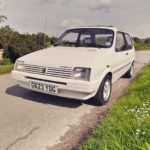
- Lyndon C: This is Mertyl, a family owned from new 1989 metro mozaic, she’s a 998 with 50k on the clock. She has lived in Gloucester all her life with her recently deceased owner who used to work for Prescott hill climb so I’m told. Prior to him his wife owned it but passed the car onto him after giving up driving. It now lives with me in Gloucester, using it to commute to work which is only a stone’s throw away. In my ownership she has had a full body machine polish, refurbished brakes and is now sat on some 12 inch minilites after retiring the old metric steels. Plans are a few bits of bodywork and just little bits and bobs to improve her without loosing her originality too much.
-
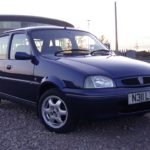
- Craig C: I Purchased this lovely Tahiti Blue Rover 111 in 2003. It was great fun to drive compared to many of my friends more fashionable superminis of the time such as the Vauxhall Corsa and Ford Fiesta. This was no doubt down to its free revving, light weight k-Series engine and superb interconnect Hydrogas suspension, that also gave a smooth ride. During my ownership I did upgrade the GSi interior with some of the more luxurious trim from the earlier Rover Metros such as the Si sports interior and walnut door cappings. I’ve always admired Rover for making a small car with such opulent woven carpets, good quality leather and walnut veneer trim . A remarkable , British designed and built affordable car.
-
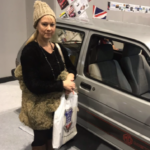
- Donna M: I had driving lessons in a metro where I live but my instructor didn’t have dual control. I wasn’t that good at the time and could only go faster than slower. Off I went into a massive telegraph pole and the instructor couldn’t stop me. We were both ok he was in tears, has only had the Metro a few days. I told my husband this story so he made me have a photo at the NEC with a metro that looked like that one. I never ever had another driving lesson put me off for life.
-
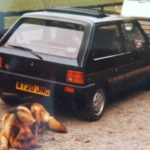
- Ian C: This was my MG Metro, it was only two years old when I got it, it was my 3rd car, but the newest car that I had ever owned. It felt so fast and sporty and I drove many miles in it, but managed to do the engine in within 18 months, very tappety sounding and smokey, advised to get rid. I enjoyed it and it had a Britax folding sunroof in it too and the fancy red grille to match the carpets and seat belts. No photo of me with it, but one of Jipp the Alsatian keeping an eye on it.
-
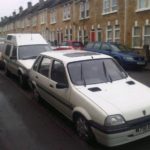
- Martyn D: I still own my Metro, on SORN in my garage. Probably a bit modern for your use, but I thought I would contribute. This was my ‘fleet’ only six years ago but my garage door didn’t have the clearance to accommodate the Maestro camper van and living on the street left her prey to tin worm, so I had to let her go!
-
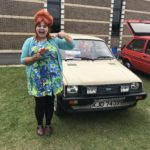
- Steph – Idriveaclassic: This is me and my metro Jill at the Mini and Metro day at the British Motor Museum, summer 2019 where Jill won the Daily Driver award.
-
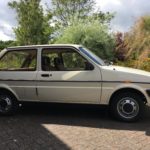
- Norman T: I have owned ‘Polly’ since new and she’s covered just under 40,000 miles. My partner learnt to drive in her and used her as daily driver until 1999 when Polly retired from daily duties she returned to the road in 2018 after 19 years. For a small car the Metro is amazingly spacious and comfortable.
-
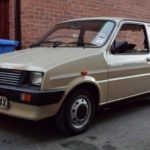
- Si P: I’m a Mini man. Have been for as long as I can remember, but the Metro has always played a part in my driving history too. I started learning to drive in a Corsa with a national driving school, but soon switched to a local school who used a K series Metro. Once I passed, I bought my first car, which was a Mini. My first Metro arrived three years later when my then partner upgraded, and I ended up with it. It died of the dreaded tin worm a couple of years later, but I was hooked. I had a brief metroless spell, although I’ve always had Minis, including my Paul Smith Mini which I bought new in 1998. However in 2008, I bought a 1981 Metro at the Pride Of Longbridge event. A few years later, I purchased a 1980 Metro which had had a brief cameo in the TV show Ashes to Ashes. Then finally, in 2017, I managed to acquire a K series Metro that was the exact same year, specification and colour as I passed my test in, so it all came full circle.
-
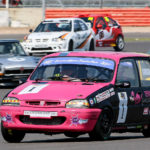
- Philip G: This is my rover 100 I bought in 2011 from a small car dealer in Abingdon. It was an 8v rover k series 1.4, it became known as ‘Barbie’ with the introduction of the pink paint. It was destined to be a race car in the MG Metro Cup. My dad and I transformed the car into a race car for £1500 and were on the grid for our first race at Donington in 2012. I actually rolled the car at this race! The joke is it had no anti roll bars! It was a stripped out road car with a cage and extinguisher that’s all I could afford to do and on the R100 arb’s were not fitted! Over the years it was never raced in the same form, with no testing we made changes to improve the car for every single race we entered. We got a rear arb for its second race (along with front dampers which again were not standard on the car) and a front arb for the third race! After a couple of races we swapped the 8v engine for a 16v version, we ended up getting 130bhp from a wasted spark engine still running the Rover mems3 ecu tuned by the man who I believe was involved in its conception, Mark Stacey. I campaigned the car with my dad, Gavin, as my mechanic in 2013, 14 and 15. We won the overall and class B championships in 2015. The picture below is at Silverstone in 2016 at MG Live the only time the car has run since 2015 – we wanted to run the number 1 at what we considered our home circuit. My dad has become so proud of this little car we will probably never sell it. It is actually almost ready to be back on track in 2021!
-

- Gerrard S: Growing up my dad had a succession of Austin Metros so when I started learning to drive in 2004 there was only one car I wanted… it had to be a Metro! At the time there weren’t many coming up for sale but one morning before lessons started I was browsing AutoTrader and found a red Rover 100 only 1 mile away! By the end of the day my parents and grandparents had gone out and bought it for me after seeing what great condition it was in. Fast forward 16 years and it’s still with me, having had a lot spent on it over the years! The car has won awards at various shows and I now run the Metropower owners group www.metropower.info – the site I joined for advice when I first started out with my own Metro!
-

- Derek & Joanne N: We have had five Metro’s it was my other half’s second car she had a mini before this we then had 3 others after that we would have had another but they stopped making them the last one we had the head gasket went so we sold it for £100 it was a P Reg Knightsbridge se I see it once a month or so later but never see it again 2 years ago I was looking at a classic car paper and saw a buyer’s write up about a metro pro’s and con’s I purchased this 1989 metro mosaic with 22000 miles on the clock with hardly any rust on it had quite a few dents in it that have now gone and new bumpers he now looks a picture and also now called Morris the metro when I picked it up I drove it around the M25 and smiled all the way home it did not miss a beat it also has a friend Molly the Mini it shares the garage with.
-
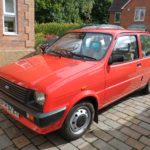
- Robin S: This is my Mk1 Austin Metro which I have owned for over 23 years now. She is a 1983 1.0L and has covered less than 20k. Only the second owner she still bears the no plates of the original dealer, has original service book and Supercover card. Sadly not many of the original Mk1’s remain in existence. This one probably belongs in a museum!
-
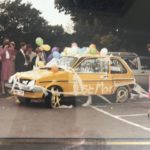
- Caroline B: Here’s our much loved Metro setting off for honeymoon touring the Yorkshire Dales &Moors in 1982. It was my husband’s company vehicle – he worked at an estate agency. Despite the wedding decorations all over the car, we picked up 2 parking fines in York! Miserable! But a lovely car.
-

- Liz M: This is George. He was my first car on passing my test, and being a confirmed biker at the time I was seriously unimpressed with my ‘cage on wheels’….that didn’t last though. He’d had a once over from Peter Baldwin, many times Metro series winner (and Mini Miglia, and many others) who was also a highly respected engine tuner…so George was set up as well as he could be, and handled like a go-kart. I had him for 18 years, I had a cosmetic restoration done in 2013 once his doors were more gaffer tape than metal, because he’d more than earned it, slowly moving from occasional shopping trolley while I still rode bikes, to my everyday vehicle once balance issues stopped me riding. He never let me down in many thousands of miles and many, many adventures. I learnt car maintenance doing routine services on him, determined not to let him down either. Before I sold him on, because the Norfolk rural roads were a bit much for something as precious as George, I took him to a photoshoot with the Lancaster ‘Just Jane’ who was also born at Longbridge. That was the pinnacle of our time together. He now lives with a collector up Coventry way, and to my knowledge is a pampered show vehicle. As he should be. I have never driven a car that fun before or since, and with modern cars removing more and more of the driver experience, I doubt I ever will.
-
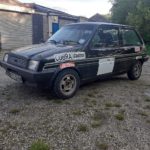
- Ray & Tomy M: My son bought an old Austin Metro for parts, last year, and then discovered through due diligence that it was a special Metro that was used to promote the Metro plus range of accessories, that was to follow, a brochure was produced, but was shelved as Abingdon was closing. Also it turned out to be a pre-production car with differences from launched cars and is known to be the 4th oldest in existence to date. It was sold to an employee who stripped it to a shell and turned it into a rally car and was used as such from 1980 to 1989, with the build featured in the popular copies of Cars and Car Conversions magazine. Since 1989 it has laid in a wooden garage, unloved and untouched, and only came to light as the property owner wanted the garage pulled down. The car has been left as found and sympathetically restored and MOT’d.
Gregg H: In 1995 I was working as an art director at an advertising agency in London called KMM, it was set up by the departing head of Rover marketing Kevin Morley. Myself and my copywriter partner were set the task to advertise the Kensington derivative of the Rover 100. It was at the height of the competition with Renault and their Clio, they had Nicole, and we had Nathalie. A previous spot had featured Nathalie shopping in the ultra snobbish Burlington arcade in Knightsbridge. In the Kensington spot we came up with the idea of Nathalie’s Rover 100 Kensington being ‘hijacked’ by the close protection motorcycle police officers who were supposed to follow a certain Princess of the time. We shot the commercial in and around Kensington over a few days in spring 1995, the weather wasn’t great but with a little film magic, fake petals and flowers we managed to give the impression of a spring day. Not everything went to plan though, our first star car fell off the back of the truck it arrived on and because of a mix up with shooting permits in Kensington park, we found ourselves, along with the whole crew, arrested for a short time by the park police.
More from the Museum
1986 MG Metro 9x 6 cylinder turbo prototype
1985 MG Metro 6R4 rally car
1979 Austin Metro Notchback
1983 MG Metro 6R4 Prototype
Archive information
The archival footage used in this exhibition are extracts from “The Best of British Leyland”.
The full film is available to purchase from the Museum gift shop and online at: https://shop.britishmotormuseum.co.uk/collections/dvds.
For more information about our film library please email photo@britishmotormuseum.co.uk
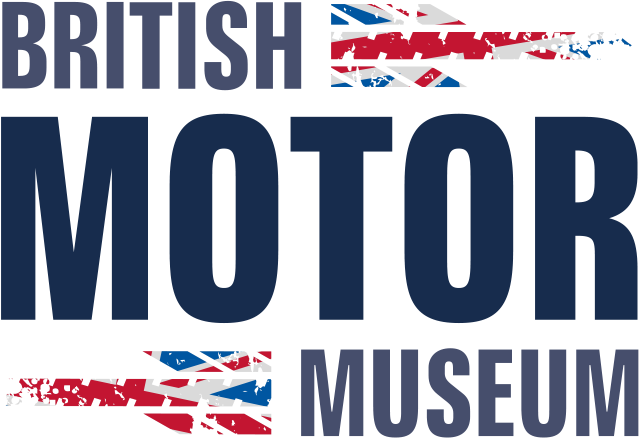





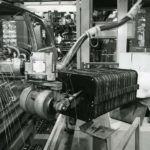
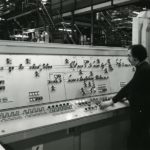
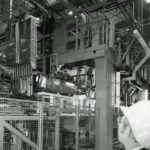
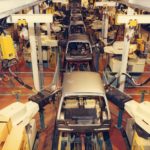
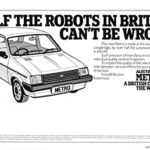
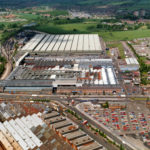

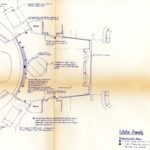
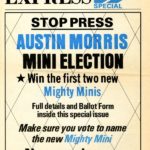
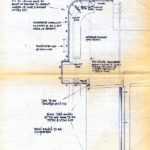
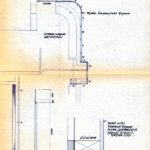
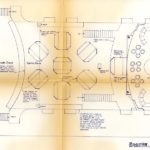

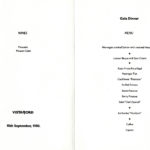




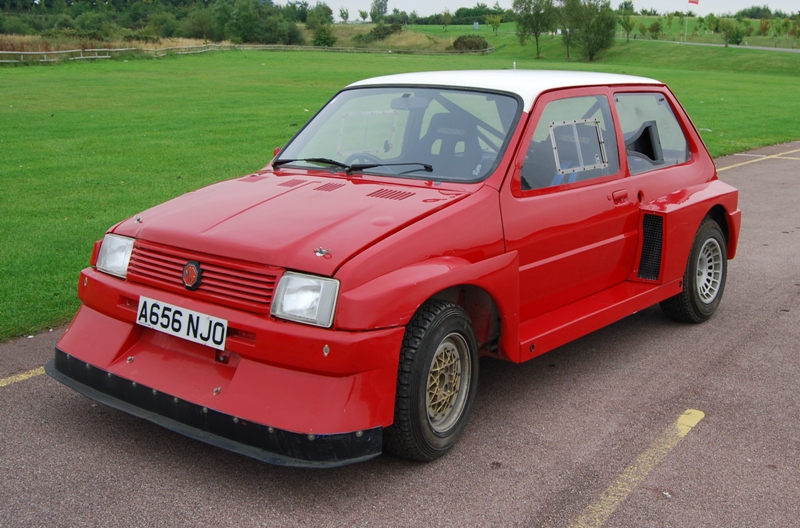
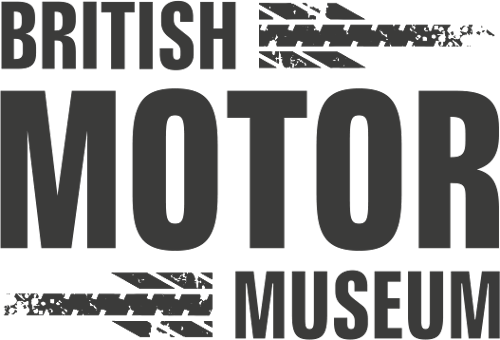




.png)
